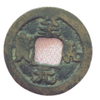分享到微信,
请点击右上角。
再选择[发送朋友]
或[分享到朋友圈]

古钱币是有一定数量并且它是不可再生资源,经过数千年的沉淀,随着收藏钱币的群体扩大,古钱币的存世量日益减少,收藏市场向来物依稀为贵,因此导致古钱币的价格快速走高。同时,古钱币的收藏价值也越来越凸显至和元宝是中国古代钱币之一。
北宋仁宗至和元年(公元1054年)铸造,另有至和通宝和至和重宝,均为对钱。“至和元宝”小平钱有隶书,楷书,篆书三种书体。“至和重宝”有折二、折五钱,存世量少。折五钱背有“坊”,“虢”等记地名者更为稀少。另有铁钱。
北宋仁宗赵祯,至和元年(公元1054年—1055年)铸造,另有“至和通宝”和“至和重宝”,均为对钱。“至和元宝”小平钱,有隶书,楷书,篆书三种书体。至和元宝小平隶书版式单一,仅有小字小样、大字大样之分。查阅各类钱谱书籍,小平隶书至和元宝只有平头元的图片。但是日本的《古泉大全(北宋篇)》,一书中可查到,至和元宝隶书小平有平头元、左挑元两式。由此可见,至和元宝隶书在北宋小平钱中属于少见品,一般标3至4级,是集币者追求的目标之一,美品更是难得。
“至和重宝”有折二、折五钱,存世量少。折五钱背有“坊”,“虢”等记地名者更为稀少。另有铁钱。“至和通宝”铸造量大,存世极多,为常见品。北宋钱铸量浩大,版别繁多,书法多彩,在我国历代铸币史上具有重要的地位。至和钱有篆、真、隶书体35余式,型值有小平、折二、折三,其中元宝只有小平一型。
对钱主要是从两种钱币的钱文内容的同一性体现出来,还有两种钱币的铜色、钱制、重量、肉厚、内穿、外廓完全同一规格。对钱的钱文用不同的书体书写,可以配对。对钱亦称对子钱、对称钱、对制钱。日本学者称中国对钱为“复合钱”。
宋代对钱是我国传统美学对称美的展示。中国传统美学对称美,其特点体现为事物统一性与对应性以及相对性,对称美在我国的修建、纹饰、装潢、律诗、楹联、文字结构等方面都有充实体现。厚薄所谓“对钱”,是指钱文相同而书体差异、可以成双配对的钱币,又称对文钱或对书钱,日本泉界称之为“切合泉”。不过目前关于至和元宝的记载,还是比较少的。


There are a certain number of ancient coins and they are non renewable resources. After thousands of years of precipitation, with the expansion of coin collection groups, the survival of ancient coins is decreasing day by day. The collection market has always been rare and expensive, resulting in the rapid rise of the price of ancient coins. At the same time, the collection value of ancient coins is becoming more and more prominent. Heyuanbao is one of the ancient coins in China.
In the first year of Zhihe of Renzong in the Northern Song Dynasty (1054 AD), there were Zhihe Tongbao and Zhihe chongbao, both of which were pairs of money. "Zhihe Yuanbao" Xiaoping Qian has three styles: official script, regular script and seal script. "Zhihe chongbao" has a discount of two or five yuan, which has a small amount in the world. There are few people who remember place names such as "Fang" and "Guo" on the back of five coins. And iron money.
Zhao Zhen, Renzong of the Northern Song Dynasty, was cast in the first year of Zhihe (1054-1055 AD). There are also "Zhihe Tongbao" and "Zhihe chongbao", both of which are pairs of money. "Zhihe Yuanbao" Xiaoping Qian has three styles: official script, regular script and seal script. Zhihe Yuanbao Xiaoping official script has a single format, which is only divided into small type and large type. Refer to all kinds of money spectrum books. There are only flat head yuan pictures from Xiaoping Lishu to heyuanbao. However, in Japan's Guquan Daquan (Northern Song Dynasty), it can be found that Zhihe Yuanbao Lishu Xiaoping has two types: flat head yuan and left pick yuan. It can be seen that Zhihe Yuanbao official script is a rare product in Xiaoping money of the Northern Song Dynasty. It is generally marked with levels 3 to 4, which is one of the goals pursued by coin collectors, and beautiful products are even more rare.
"Zhihe chongbao" has a discount of two or five yuan, which has a small amount in the world. There are few people who remember place names such as "Fang" and "Guo" on the back of five coins. And iron money. "Zhihe Tongbao" is a common product with a large amount of casting and a lot of survival. The Northern Song Dynasty has a large amount of coins, various editions and colorful calligraphy, which plays an important role in the history of coinage in China. Zhihe Qian has more than 35 styles of seal, true and official script. The types and values include Xiaoping, fold two and fold three, of which the Yuanbao is only Xiaoping one.
Money is mainly reflected from the identity of the content of the money text of the two coins, and the copper color, money system, weight, meat thickness, inner wear and outline of the two coins are completely the same specification. The money script for money is written in different styles and can be paired. Pair money is also called pair money, symmetrical money and pair making money. Japanese scholars call China's money "compound money".
Money in the Song Dynasty is the display of the symmetrical beauty of China's traditional aesthetics. The symmetrical beauty of Chinese traditional aesthetics is characterized by the unity, correspondence and relativity of things. The symmetrical beauty is fully reflected in China's construction, decoration, decoration, regular poetry, couplets, text structure and so on. The so-called "pair of money" refers to the coins with the same money and text but different calligraphy style, which can be paired in pairs, also known as pair of money or pair of money for books, which is called "fit spring" in the Japanese spring circle. However, there are few records about Zhihe Yuanbao.

分享到微信,
请点击右上角。
再选择[发送朋友]
或[分享到朋友圈]

